
The Massachusetts Bay Transportation Authority is the public agency responsible for operating most public transportation services in Greater Boston, Massachusetts. The MBTA transit network includes the MBTA subway with three metro lines, two light rail lines, and a five-line bus rapid transit system ; MBTA bus local and express service; the twelve-line MBTA Commuter Rail system, and several ferry routes. In 2023, the system had a ridership of 239,981,700, or about 812,400 per weekday as of the third quarter of 2024, of which the rapid transit lines averaged 267,700 and the light rail lines 102,500, making it the fourth-busiest rapid transit system and the third-busiest light rail system in the United States. As of the third quarter of 2024, average weekday ridership of the commuter rail system was 109,300, making it the fifth-busiest commuter rail system in the U.S.
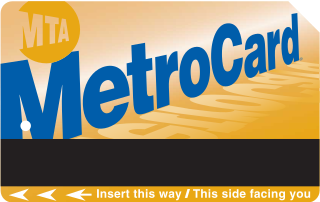
The MetroCard is a magnetic stripe card used for fare payment on transportation in the New York City area. It is a payment method for the New York City Subway, New York City Transit buses and MTA buses. The MetroCard is also accepted by several partner agencies: Nassau Inter-County Express (NICE), the PATH train system, the Roosevelt Island Tramway, AirTrain JFK, and Westchester County's Bee-Line Bus System.

A ticket machine, also known as a ticket vending machine (TVM), is a vending machine that produces paper or electronic tickets, or recharges a stored-value card or smart card or the user's mobile wallet, typically on a smartphone. For instance, ticket machines dispense train tickets at railway stations, transit tickets at metro stations and tram tickets at some tram stops and in some trams. Token machines may dispense the ticket in the form of a token which has the same function as a paper or electronic ticket. The typical transaction consists of a user using the display interface to select the type and quantity of tickets and then choosing a payment method of either cash, credit/debit card or smartcard. The ticket(s) are then printed on paper and dispensed to the user, or loaded onto the user's smartcard or smartphone.

The Pioneer Valley Transit Authority (PVTA) oversees and coordinates public transportation in the Pioneer Valley of Western Massachusetts, offering fixed-route bus service, paratransit service, and senior van service. PVTA was created by Chapter 161B of the Massachusetts General Laws in 1974. Based in Springfield, Massachusetts, PVTA serves Hampden and Hampshire counties, and provides connecting service to CTtransit in Hartford County, Connecticut, to FRTA in Franklin County, and to WRTA in Worcester County. It is the largest regional transit authority, and second largest public transit system in Massachusetts after the Massachusetts Bay Transit Authority, providing service to over 11 million riders annually across 24 municipalities in the region, with about 70% of all riders using the system as their primary mode of transit.

The Edmonton Transit Service (ETS) is the public transit service owned and operated by the City of Edmonton in Alberta, Canada. It operates Edmonton's bus and light rail systems. In 2023, the system had a ridership of 87,646,600, or about 305,500 per weekday as of the third quarter of 2024.
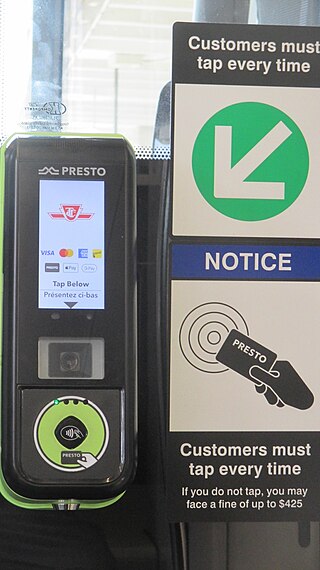
Fares to use the Toronto Transit Commission (TTC) transit system in Toronto, Ontario, Canada, can be paid with various media. The price of fares varies according to age, occupation, income level, and health condition of riders.

The Presto card is a contactless smart card automated fare collection system used on participating public transit systems in the province of Ontario, Canada, specifically in Greater Toronto, Hamilton, and Ottawa. Presto card readers were implemented on a trial basis from 25 June 2007 to 30 September 2008. Full implementation began in November 2009 and it was rolled out across rapid transit stations, railway stations, bus stops and terminals, and transit vehicles on eleven different transit systems.
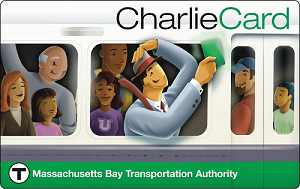
The CharlieCard is a contactless smart card used for fare payment for transportation in the Boston area. It is the primary payment method for the Massachusetts Bay Transportation Authority (MBTA) and several regional public transport systems in the U.S. state of Massachusetts. It is used on the MBTA's subway and bus services, but is not currently accepted on the MBTA Commuter Rail and ferries.
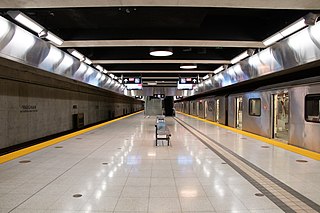
Vaughan Metropolitan Centre is a rapid transit station in Vaughan, Ontario, Canada. Opened on December 17, 2017, it is the north terminus of the western section of the Toronto subway's Line 1 Yonge–University. It is operated by the Toronto Transit Commission (TTC) and is one of two subway stations in the system outside of Toronto's city limits. It provides connections to a York Region Transit (YRT) Viva bus rapid transit route along the Highway 7 Rapidway, which is also used by a Brampton Transit Züm route, as well as several local YRT bus routes.

The Breeze Card is a stored value smart card used on bus and rapid transit routes in Atlanta, Georgia, United States. It is part of an automated fare collection system which Metropolitan Atlanta Rapid Transit Authority (MARTA) introduced to the general public in early October 2006. The card automatically debits the cost of the passenger’s ride when placed on or near the Breeze Target at the fare gate. Transit riders are able to add value or time-based passes to the card at Breeze Vending Machines (BVM) located at all MARTA stations. The major phases of MARTA's Breeze transformation took place before July 1, 2007 when customers were still able to purchase TransCards from ridestores or their employers. They were also able to obtain paper transfers from bus drivers to access the train. As of July 1, 2007 the TransCard and the paper transfers were discontinued and patrons now use a Breeze Card or ticket to access the system, and all transfers are loaded on the card. Breeze Vending Machines (BVM) distribute regional transit provider passes The Breeze Card employs passive RFID technology currently in use in many transit systems around the world.

SmartLink is a RFID-enabled credit card-sized smartcard that is the primary fare payment method on the PATH transit system in Newark and Hudson County in New Jersey and Manhattan in New York City. It was designed to replace PATH's paper-based farecard, QuickCard, and there was plans to expand its usage throughout most transit agencies in the tri-state area. The SmartLink card has been available to the public since July 2, 2007. Although the MetroCard used on the Metropolitan Transportation Authority (MTA)'s transit system can also be used on the PATH, the reverse is not true for SmartLink, which cannot be used on the MTA's system.

The ORCA card is a contactless, stored-value smart card system for public transit in the Puget Sound region of Washington, United States. The card is valid on most transit systems in the Seattle metropolitan area, including Sound Transit, local bus agencies, Washington State Ferries, the King County Water Taxi, and Kitsap Fast Ferries. It was launched in 2009 and is managed by the Central Puget Sound Regional Fare Coordination Project, a board composed of local transit agencies.
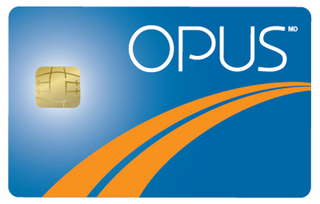
Opus is a rechargeable, dual interface (contact/contactless) stored-value smart card using the Calypso Standard and is used by major public transit operators in Greater Montreal and Quebec City, Quebec, Canada. It complies with the ISO/IEC 14443 standard for smartcards and can be read by smartphones with an NFC antenna.

The Transit Access Pass (TAP) is a contactless smart card used for automated fare collection on most public transport agencies within Los Angeles County, California. The card is also available in electronic form, free of charge, in Apple Wallet, thereby bypassing the need to purchase the plastic USD $2 card. It is administered by the Los Angeles County Metropolitan Transportation Authority (Metro), and the card and fare collection systems are manufactured by Cubic Transportation Systems.
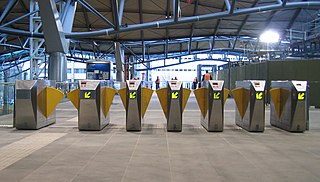
An automated fare collection (AFC) system is the collection of components that automate the ticketing system of a public transportation network – an automated version of manual fare collection. An AFC system is usually the basis for integrated ticketing.

The Compass card is a contactless smart card automated fare collection system used primarily for public transit in Metro Vancouver, British Columbia, Canada. Compass card readers were first implemented as a beta in September 2013. Due to delays, full implementation to the general public began in August 2015. The system is operated by Cubic Transportation Systems and is managed by TransLink, the transportation authority for the region.
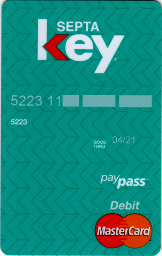
The SEPTA Key card is a smart card that is used for automated fare collection on the SEPTA public transportation network in the Philadelphia metropolitan area. It can be used throughout SEPTA's transit system, including buses and SEPTA Metro, and on Regional Rail.
OMNY is a contactless fare payment system, currently being implemented for use on public transit in the New York metropolitan area. OMNY can currently be used to pay fares at all New York City Subway and Staten Island Railway stations, on all MTA buses, AirTrain JFK, Metro North's Hudson Rail Link, and on the Roosevelt Island Tram; when completely rolled out, it will also replace the MetroCard on Bee-Line buses, and NICE buses. OMNY will also expand beyond the current scope of the MetroCard to include the Long Island Rail Road and Metro-North Railroad.
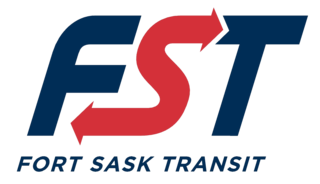
Fort Sask Transit (FST) is a public transit service in the city of Fort Saskatchewan, Alberta. It operates two routes within the city, and a third route is contracted to Strathcona County Transit to connect with its service network.

The Arc card is a contactless smart card and automated fare collection system being introduced to transit services in the Edmonton Metropolitan Region. The initial launch started in the last week of August 2021, when U-Pass holders began receiving Arc Cards from their respective institutions. A pilot-testing period with 500 adult fare users began on January 1, 2022, and the system opened to all adult fare-paying passengers on November 21, 2022. As of January 2024, Arc is also available for youth and students, and seniors. Low Income and Paratransit users were added in August 2024.




















